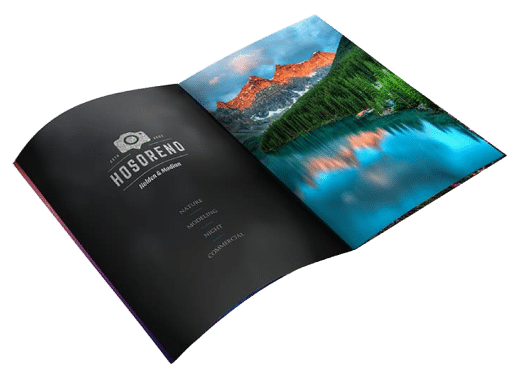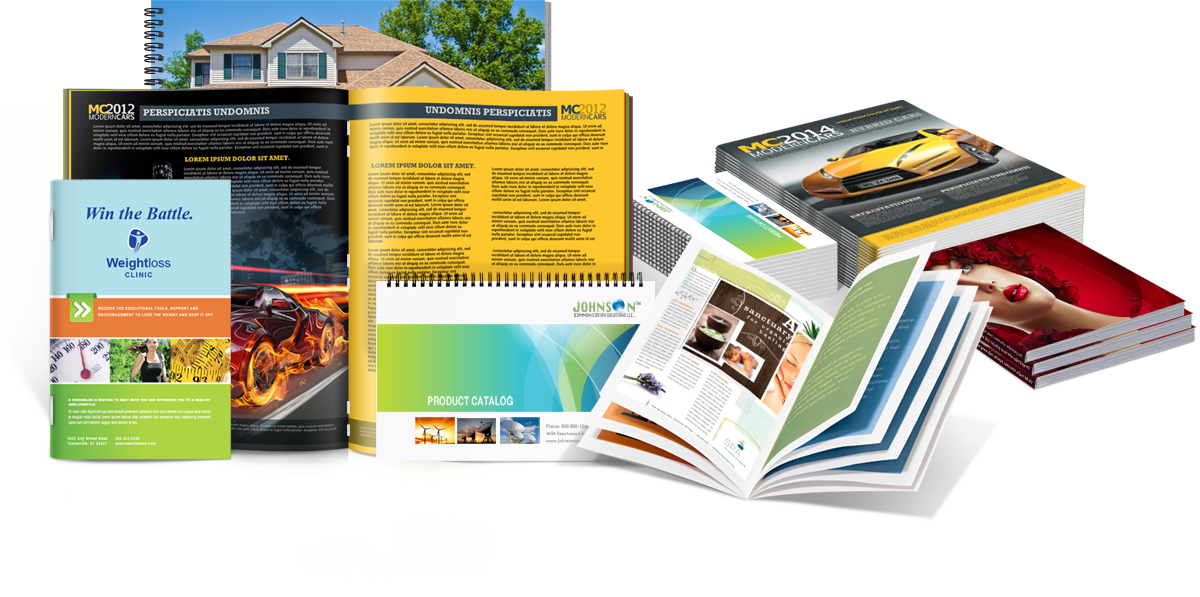What Every Marketer Should Know About Interactive Booklet Printing
What Every Marketer Should Know About Interactive Booklet Printing
Blog Article
The Necessary Overview to Comprehending Booklet Printing Options and Techniques
The procedure of pamphlet printing includes multiple factors to consider that can substantially affect the end product. From picking the proper style and size to recognizing the nuances of binding methods, each selection plays a necessary function. Additionally, variables such as paper supply and printing techniques more influence the effectiveness of the pamphlet. As one navigates these alternatives, it becomes vital to grasp just how they interconnect and what that means for the general outcome.
Recognizing Booklet Dimensions and styles
When considering booklet printing, understanding the various layouts and sizes offered is crucial for achieving the desired discussion. Booklets can be created in numerous styles, consisting of saddle-stitched, spiral-bound, and perfect-bound, each offering distinct benefits. Usual sizes vary from standard letter (8.5 x 11 inches) to smaller sized alternatives like A5 (5.8 x 8.3 inches), permitting adaptability based on material and target audience.Selecting the ideal size can influence both the format and viewers engagement. Bigger dimensions might fit aesthetically driven web content, while smaller styles might be extra portable and easy to use. In addition, the number of pages impacts the option of binding approach, as thicker booklets may need stronger bindings. Inevitably, understanding these aspects enables for a much more customized strategy, ensuring that the final product lines up with the designated message and visual, improving the general efficiency of the communication.
Picking the Right Paper Supply

Binding Techniques: Considerations and choices
When it pertains to binding approaches for booklets, a number of choices are readily available, each with distinct advantages. Saddle stitch binding provides a cost-efficient solution for thinner booklets, while ideal binding methods give an even more polished try to find thicker magazines. Wire-O binding sticks out for its sturdiness and ease of use, making it ideal for records that call for flexibility.
Saddle Stitch Binding
Saddle stitch binding uses a economical and functional service for assembling pamphlets, making it a prominent selection amongst authors and organizations. This binding approach includes folding sheets of paper in fifty percent and stapling them along the fold line, producing a neat and organized look. Commonly ideal for pamphlets with a reduced page count, saddle sewing is excellent for publications, pamphlets, and instructional materials. The simpleness of this method enables for quick manufacturing and is usually preferred for advertising products or short runs. It is essential to keep in mind that saddle stitch binding may not be ideal for thicker brochures, as the spine might not hold up under enhanced weight. Overall, it continues to be a trusted choice for many printing tasks.
Perfect Binding Techniques
Perfect binding is an extensively utilized strategy that supplies a professional and refined coating to brochures and magazines. This method entails gluing the pages with each other at the back utilizing a solid adhesive, allowing for a tidy edge and the capability to hold a bigger number of web pages contrasted to saddle stitching. Perfect binding is particularly ideal for thicker pamphlets, such as catalogs and yearly records, where a tough, level back is wanted. In addition, it offers the choice for a published cover that can be developed to boost aesthetic appeal. Considerations such as web page matter, paper weight, and the planned usage of the booklet ought to be taken into account, as they can impact longevity and overall quality.
Wire-O Binding Choices
Wire-O binding, understood for its toughness and adaptability, offers an outstanding choice for brochures that need simple page turning and an expert look. This binding technique utilizes a collection of metal loops that hold pages securely, allowing them to lie flat when open. It is particularly suitable for directories, presentations, and manuals because of its robust nature. Wire-O binding is available in various shades and sizes, fitting different web page matters and thicknesses. In addition, it allows the addition of tabs and covers, boosting the pamphlet's overall aesthetic. Factors to consider for Wire-O binding include the option of cable color, the dimension of the loops, and the extent of customization wanted, every one of which can profoundly affect the last item's look and functionality.
Digital vs. Offset Printing: Which Is Best for You?
When picking a printing technique for booklets, understanding the distinctions between digital and counter printing is vital. Digital printing utilizes modern-day innovation to produce high-quality prints promptly and economically, making it ideal for brief runs or jobs requiring fast turnaround times. It permits customization, giving the capacity to print on-demand with marginal waste.In contrast, balance out printing is a conventional approach that stands out in producing big amounts with consistent high quality. It involves moving ink from a plate to a rubber blanket, after that to the paper, which causes exact information and dynamic shades. Nonetheless, offset printing commonly calls for longer setup times and is much more cost-efficient for larger volumes.Ultimately, the option in between electronic and offset printing depends upon task requirements, budget, and preferred amount. For tiny, time-sensitive jobs, electronic could be the finest choice, while countered may be more suitable for larger, top notch manufacturings.

Designing Your Brochure: Tips and Best Practices
When designing a pamphlet, mindful interest to design, i thought about this font selection, and shade usage can significantly enhance its performance. A well-structured format guides the reader's eye, while appropriate typefaces ensure readability and convey the wanted tone. In addition, reliable use color can stimulate feelings and highlight vital details, sites making the general design extra impactful.
Selecting the Right Layout
Just how can one successfully choose the appropriate design for a booklet? It is essential to examine the booklet's objective and target audience. A clean, arranged layout boosts readability and engagement. Making use of a grid system can aid in straightening elements constantly, creating an expert look. Furthermore, incorporating visual power structure with differing sizes and positionings of photos and text can lead the reader's eye and highlight vital info. It is additionally vital to leave adequate white room, which prevents overcrowding and enables better focus. Lastly, examining different designs via mock-ups can provide insight into just how the style carries out in real-world scenarios, making certain that the end product fulfills both useful and aesthetic requirements.
Picking Ideal Fonts
A well-chosen font can greatly enhance the overall design of a booklet, complementing the layout and reinforcing the content's message. The selection of fonts should consider readability, especially for body message, as it assures the details is obtainable to all viewers. Sans-serif font styles are commonly liked for electronic styles, while serif fonts can lend a traditional feeling in published materials. It's recommended to limit font selections to 2 or three to maintain aesthetic comprehensibility. Furthermore, font size plays a vital duty; headings must be not overwhelming yet distinctive, while body message must fit for reading. When picking font styles, alignment with the pamphlet's style and target audience is important for effective interaction and aesthetic allure.
Efficient Use Shade
Color serves as a powerful device in pamphlet layout, forming understandings and directing visitor feelings. It can evoke sensations of peace, exhilaration, or trust, depending upon the tones selected. Designers must consider color theory concepts, making certain that the chosen combination straightens with the pamphlet's message and target audience. For instance, utilizing cozy shades like red and orange can create urgency, while cooler tones like blue and eco-friendly foster tranquility.Additionally, comparison plays a vital function; complementary shades can boost readability and aesthetic allure. Uniformity in shade use throughout web pages additionally reinforces brand name identification and communication. Inevitably, effective color implementation not just catches interest however likewise strengthens the brochure's function, making it a necessary facet of effective style.
Completing Touches: Coatings and Special Effects
While many consider the web content and format of a booklet the most vital elements, the finishing touches, such as coatings and unique effects, play a vital function in boosting its total appeal. Coatings can offer security and longevity, ensuring that the booklet stands up to deterioration. Matte finishes offer an innovative, non-reflective surface, while glossy layers can make shades appear even more lively and appealing. Special effects, like embossing or aluminum foil stamping, include a tactile measurement that can produce a remarkable perception. These techniques can highlight certain areas, attracting attention to vital info or developing visual passion. Furthermore, UV coating can supply a high-shine finish that raises the overall look.Together, these completing touches not just improve the pamphlet's aesthetic however also interact professionalism and interest to information, ultimately leaving a long-term effect on the visitor.
Price Considerations for Brochure Printing
Understanding the different expense factors to consider for booklet printing is necessary for businesses and organizations aiming to enhance their spending plans. Key elements affecting prices consist of the choice of binding, paper, and ink approaches. Greater top quality materials, such as premium paper or specialized inks, commonly increase the overall cost. Furthermore, the dimension and web page matter of the pamphlet play a significant role; larger booklets need more resources and time to produce.Another crucial factor to consider is the printing strategy, whether electronic or balanced out, as each has its Check Out Your URL very own pricing framework and viability for different amounts. Businesses must additionally factor in design costs, which can vary based upon intricacy and using specialist solutions. Inevitably, delivery and handling charges can include to the overall, particularly for large orders. By assessing these aspects, organizations can make informed choices that straighten with their economic abilities while accomplishing the preferred quality in their published products.
Often Asked Concerns
What Are the Environmental Impacts of Pamphlet Printing?
The ecological effects of booklet printing consist of logging from paper production, carbon emissions from transport, and waste generation from disposed of materials - Booklet Printing. Sustainable techniques, such as utilizing recycled paper and environment-friendly inks, can reduce these effects
Just How Can I Make Sure Color Precision in My Brochure?
To guarantee shade precision in a booklet, one need to make use of calibrated displays, utilize professional shade profiles, perform test prints, and select high-quality printing solutions that provide shade matching and proofing choices for best outcomes.
What Is the Typical Turn-around Time for Booklet Printing?
The regular turnaround time for pamphlet printing varies relying on the complexity and amount - Booklet Printing. Typically, it varies from a couple of days to two weeks, influenced by aspects such as printing approaches and completing needs
Exist Minimum Order Quantities for Booklet Printing?

Can I Publish Booklets in Several Languages?
Publishing booklets in numerous languages is possible. Numerous printing solutions supply options for bilingual or multilingual layouts, allowing for efficient interaction. Careful planning warranties that design aspects suit numerous languages without jeopardizing readability or looks. Additionally, variables such as paper stock and printing techniques additional influence the efficiency of the booklet. When taking into consideration booklet printing, comprehending the various formats and dimensions readily available is crucial for achieving the wanted presentation. When picking a printing technique for brochures, understanding the distinctions in between digital and balance out printing is crucial. In addition, the dimension and page count of the booklet play a substantial role; larger pamphlets need even more sources and time to produce.Another essential consideration is the printing strategy, whether electronic or countered, as each has its own rates framework and suitability for various quantities. The environmental influences of brochure printing include logging from paper manufacturing, carbon discharges from transport, and waste generation from discarded materials.
Report this page